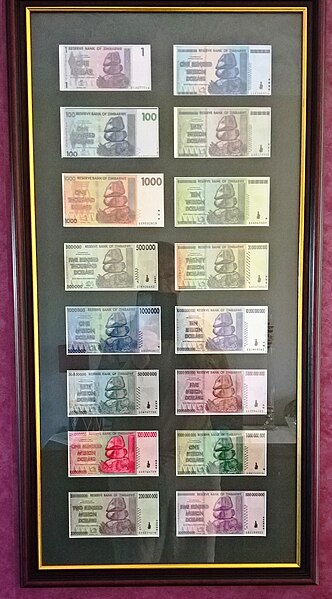Hyperinflation in Zimbabwe
Hyperinflation in Zimbabwe is an ongoing period of currency instability in Zimbabwe which, using Cagan's definition of hyperinflation, began in February 2007. During the height of inflation from 2008 to 2009, it was difficult to measure Zimbabwe's hyperinflation because the government of Zimbabwe stopped filing official inflation statistics. However, Zimbabwe's peak month of inflation is estimated at 79.6 billion percent month-on-month, 89.7 sextillion percent year-on-year in mid-November 2008.
Zimbabwean banknotes ranging from 10 dollars to 100 billion dollars printed within a one-year period. The magnitude of the currency scalars signifies the extent of the hyperinflation.
The largest denomination of a Zimbabwean banknote (Z$100,000,000,000,000, 1×1014, or 100 trillion)
Selection of 16 original un-circulated Zimbabwe notes ranging in denomination from 1 dollar to 100 trillion dollars. They are all signed by G Gono, the Governor of the Reserve Bank of Zimbabwe, in the period 2007 to 2008, who promises "to pay the bearer on demand". In 2007 Gideon Gono gained a PhD in Strategic Management from the Atlantic International University.
US banknotes, collected in Zimbabwe in 2015. Used as local currency. On display at the British Museum in London
The Zimbabwean dollar was the name of four official currencies of Zimbabwe from 1980 to 12 April 2009. During this time, it was subject to periods of extreme inflation, followed by a period of hyperinflation.
The 100 trillion Zimbabwean dollar banknote (1014 dollars), equal to 1027 pre-2006 dollars.
A Series 2008 bearer cheque for 100 million Zimbabwean dollars
A selection of Reserve Bank of Zimbabwe bearer cheques printed between July 2007 to July 2008 (now expired) ranging between 10 and 100,000,000,000 Z$ that illustrate the hyperinflation rate in Zimbabwe.





